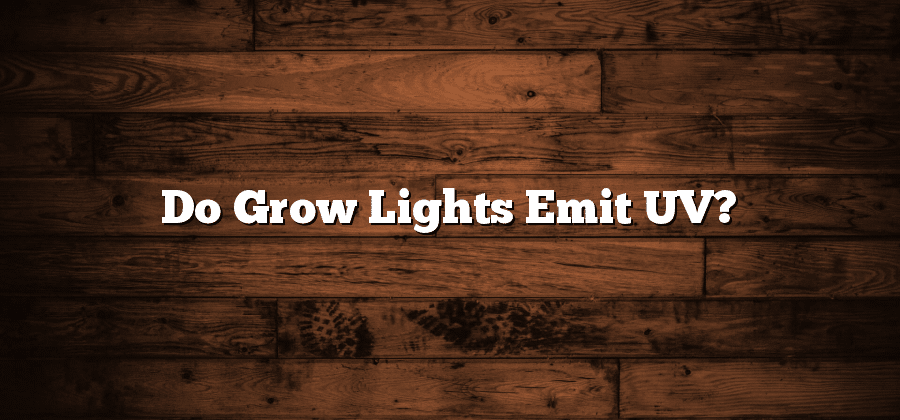The Science Behind Grow Lights and UV Emission
When it comes to indoor gardening and the cultivation of plants, the role of grow lights cannot be overstated. These artificial light sources simulate and supplement natural sunlight, thereby providing the necessary light energy for plant photosynthesis. However, in recent years, the incorporation of ultraviolet (UV) emission in grow lights has gained significant attention. UV radiation, which is a component of sunlight, is known to have both positive and negative effects on plant growth. Therefore, understanding the science behind grow lights and their UV emission is crucial for maximizing plant health and productivity.
In scientific terms, UV radiation consists of three different wavelengths: UV-A, UV-B, and UV-C. UV-A, also known as long-wave UV, comprises the majority of UV radiation and is responsible for the physiological reactions and photomorphogenic responses in plants. UV-B, or medium-wave UV, has a profound impact on pigmentation, flowering, and the production of secondary metabolites in plants. Lastly, UV-C, the shortest wavelength, possesses the highest energy potential and is effective in sterilizing pathogens and controlling diseases. The complex interaction between these different wavelengths and plant physiology has sparked interest in exploring the benefits and risks associated with incorporating UV emission in grow lights.
Understanding the Spectral Output of Grow Lights
One crucial aspect of understanding the spectral output of grow lights is recognizing the different wavelengths of light and how they can affect plant growth. Plants primarily require light in the red and blue spectrum for photosynthesis. Red light, with wavelengths around 620-780nm, promotes flowering and fruiting, while blue light, with wavelengths around 400-500nm, stimulates foliage and vegetative growth. Hence, when choosing a grow light system, it is essential to consider its spectral output to ensure optimal growth and development for plants.
Aside from red and blue light, other wavelengths, such as green and ultraviolet (UV) light, also play a role in plant growth. Green light, with wavelengths around 500-600nm, is not as efficient at driving photosynthesis as red and blue light, but it does contribute to certain processes like stomatal opening and overall plant health. On the other hand, UV light, with wavelengths below 400nm, can have both positive and negative effects on plants. While excessive UV radiation can damage plant tissues, controlled exposure to lower levels of UV light can enhance pigmentation, essential oil production, and overall plant resilience. Therefore, understanding the specific spectral output of grow lights and their influence on plant biology is critical in maximizing growth and quality in indoor cultivation.
The Impact of UV Radiation on Plant Growth
Plant growth is heavily influenced by the presence of ultraviolet (UV) radiation. While UV radiation is generally associated with harmful effects on living organisms, plants have evolved various mechanisms to cope with and utilize this type of radiation to their advantage. UV radiation can directly impact plant growth through both positive and negative effects on physiological and biochemical processes.
One of the major impacts of UV radiation on plant growth is its ability to stimulate the production of secondary metabolites. These compounds, such as flavonoids and phenolic compounds, play important roles in plant defense against biotic and abiotic stresses. UV radiation acts as a signal for plants to activate specific biochemical pathways that lead to the synthesis of these secondary metabolites. The increased production of these compounds can enhance plant resistance to pathogens, herbivores, and environmental stresses, ultimately promoting overall plant growth and health. However, excessive exposure to UV radiation can also inhibit plant growth by causing damage to DNA, proteins, and other cellular components. Thus, the impact of UV radiation on plant growth is a delicate balance between promoting positive responses and preventing harmful effects. Understanding these mechanisms is crucial for optimizing plant growth in controlled environments with artificial grow lights.
Types of Grow Lights and UV Emission Differences
One of the key considerations when choosing a grow light for your indoor gardening is the type of light it emits and whether it includes UV radiation. Different types of grow lights emit varying amounts of UV radiation, which can have both positive and negative effects on plants. It is important to understand these differences to ensure that you are providing the optimal light conditions for your plants.
LED grow lights are a popular choice among indoor gardeners due to their energy efficiency and ability to produce specific wavelengths of light. However, most LED grow lights have a limited or negligible UV emission. This can be advantageous for plants that are sensitive to UV radiation, as it reduces the risk of damage or stress. On the other hand, plants that benefit from UV exposure for enhanced growth and development may not receive sufficient UV radiation from LED lights alone. In such cases, supplementary UV lights may be necessary to provide the necessary UV spectrum for optimal plant growth.
UV-Blocking Technology in Grow Light Systems
UV-Blocking Technology in Grow Light Systems
Grow light technology has come a long way in recent years, and one development that has gained significant attention is the incorporation of UV-blocking technology in these systems. UV radiation, while beneficial in certain amounts, can have detrimental effects on plant growth. With the advancement of UV-blocking technology, growers now have the ability to fine-tune the light spectrum to optimize plant growth and avoid the negative impacts of excessive UV exposure.
By integrating UV-blocking technology, grow light systems can effectively filter out harmful UV radiation while still providing the necessary wavelengths for photosynthesis. This technology works by utilizing specialized filters or coatings on the light source, which selectively block UV light without significantly reducing other critical wavelengths. The result is a safer and more controlled light spectrum that promotes healthy plant growth without the risk of UV damage. Growers can now harness the power of artificial lighting while minimizing potential risks to their crops, ultimately maximizing productivity and quality.






